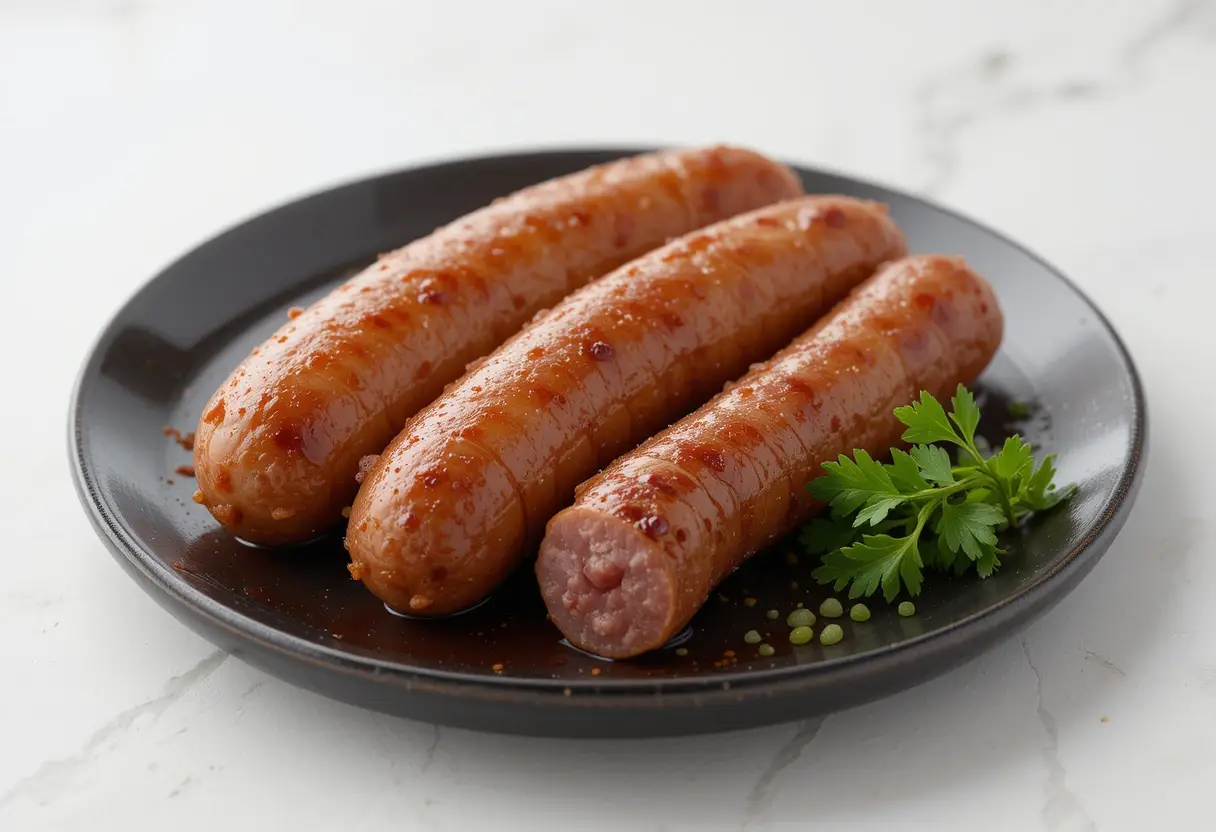Beef sausages are a global culinary delight, cherished for their rich flavor and versatility. Whether grilled to perfection, added to hearty stews, or served as a standalone dish, beef sausages offer a mouthwatering experience for all meat lovers. They are not only a staple in traditional recipes across various cultures but also a key ingredient in modern gastronomy. This article explores the fascinating history, benefits, and recipe diversity that make beef sausages a culinary treasure.
The History of Beef Sausages
The origins of beef sausages trace back thousands of years, rooted in the early human practice of preserving meat. Ancient cultures, from the Mesopotamians to the Romans, created sausages as a practical way to utilize every part of the animal, including cuts less suited for direct consumption. These early sausages often featured beef mixed with spices and grains, stuffed into casings made from animal intestines.
As trade routes expanded, so did the variety of ingredients and spices used in sausage-making. Beef sausages became particularly prominent in regions where cattle farming thrived, such as Europe, the Americas, and parts of Asia. In Germany, beef sausages evolved into iconic specialties like the knackwurst, while in the Middle East, they became a key component in dishes like the kofta. Today, beef sausages are an integral part of global cuisine, celebrated for their ability to adapt to local tastes and ingredients.
Benefits of Choosing Beef for Sausages
Beef offers several advantages as a primary ingredient for sausages, making it a popular choice among chefs and home cooks alike:
- High Nutritional Value
Beef is an excellent source of essential nutrients, including protein, iron, zinc, and B vitamins. These nutrients support muscle growth, immune function, and overall health, making beef sausages both delicious and nourishing. - Rich Flavor Profile
Beef is renowned for its deep, robust flavor that pairs beautifully with a wide range of seasonings and herbs. This versatility allows for endless creative possibilities when crafting sausage recipes. - Versatility in Preparation
Beef sausages can be prepared using various cooking methods, such as grilling, baking, frying, or boiling. Their adaptability makes them suitable for everything from quick snacks to gourmet dishes. - Dietary Flexibility
Beef sausages can cater to diverse dietary preferences. From lean cuts for a healthier option to indulgent recipes with added fat for a juicier texture, there’s a beef sausage for every palate. - Cultural Appeal
Because of its global presence, beef is widely accepted across cultures, making beef sausages a familiar yet unique offering in different cuisines. This cross-cultural appeal enriches culinary exploration and recipe innovation.
Incorporating beef sausages into your meals adds both flavor and variety to your culinary repertoire. As you dive into their history, appreciate their benefits, and experiment with diverse recipes, you’ll discover why beef sausages remain a timeless favorite.
Essential Ingredients for Beef Sausage Making
Best Cuts of Beef for Sausages
Choosing the right beef cuts is crucial for creating flavorful and juicy sausages. Here are the most common options and their ideal proportions:
- Chuck (50-70%)
- A perfect balance of lean meat and fat, chuck is the primary choice for its moisture-retaining qualities.
- Brisket or Short Rib (20-30%)
- These cuts are rich in fat, adding flavor and tenderness to the sausages.
- Round or Sirloin (10-20%)
- Leaner cuts that can be included for a healthier sausage while maintaining a good texture.
Example Ratio for a Standard Sausage Mix (1 kg/2.2 lbs):
- 700 g chuck
- 200 g brisket
- 100 g round (optional)
Spices and Seasonings: What You Need to Know
Spices and seasonings define the flavor profile of your sausage. Here’s a basic breakdown for a 1 kg batch:
- Salt: 15-18 g (1 tablespoon)
- Essential for enhancing flavor and aiding preservation.
- Pepper: 2-3 g (1 teaspoon)
- Adds a mild spiciness.
- Garlic Powder: 2-3 g (1 teaspoon)
- For a savory aroma.
- Paprika: 5 g (1 tablespoon)
- Provides color and subtle smokiness.
- Cumin or Fennel (optional): 2-3 g (1 teaspoon)
- Popular in regional sausage varieties.
- Fresh Herbs: 5 g (1-2 teaspoons, finely chopped)
- Parsley, thyme, or oregano for added freshness.
- Sugar (optional): 3-5 g (1 teaspoon)
- Helps balance the flavor in sweeter sausage varieties.
Natural vs. Synthetic Casings
Casings shape and hold the sausage, with each type offering unique benefits:
- Natural Casings
- Made from animal intestines, they provide a traditional texture and snap.
- For 1 kg of sausage, about 2-3 meters (6-9 feet) of casing is needed.
- Synthetic Casings
- Uniform and easier to handle, made from collagen or cellulose.
- Common in commercial production but less natural in texture.
Step-by-Step Guide to Making Beef Sausages at Home
Grinding the Meat: Tips and Techniques
- Preparation:
- Cut beef into small chunks. Keep the meat and grinder attachments cold to prevent fat smearing.
- Grinding:
- Use a coarse grind first, followed by a finer grind if desired.
- Mixing:
- After grinding, thoroughly mix the meat to ensure even distribution of fat and lean cuts.
Seasoning Mixes: Creating the Perfect Flavor
- Combine Spices:
- Mix all your measured seasonings in a bowl.
- Blend with Meat:
- Gradually add spices to the ground meat, mixing gently but thoroughly. Avoid overmixing to maintain texture.
- Test the Flavor:
- Fry a small patty of the mixture to taste and adjust the seasoning if needed.
Stuffing and Casing: A Detailed Walkthrough
- Prepare Casings:
- Soak natural casings in water for at least 30 minutes, then rinse inside and out.
- Set Up the Stuffer:
- Attach the casing to the sausage stuffer nozzle, leaving a small tail for tying.
- Stuffing:
- Slowly feed the meat mixture into the casing, ensuring even filling without air pockets.
- Twisting Sausages:
- Twist the casing at regular intervals to create individual links.
Cooking Your Sausages: Best Practices
- Grilling:
- Preheat the grill to medium heat and cook sausages evenly, turning frequently.
- Pan-Frying:
- Use a medium flame, adding a small amount of oil for a golden crust.
- Baking:
- Bake sausages in a preheated oven at 375°F (190°C) for 20-30 minutes.
- Poaching:
- For a healthier method, gently poach sausages in simmering water before finishing on a grill or pan.
By following these steps and using the right ingredients, you can craft delicious, homemade beef sausages tailored to your taste. Whether you’re grilling them for a backyard barbecue or preparing them for a hearty stew, the possibilities are endless!
Innovative Beef Sausage Recipes
Classic Beef Sausage Breakfast
Start your day with a hearty breakfast featuring beef sausages. Here’s a simple yet satisfying recipe:
- Ingredients: Beef sausages, eggs, toast, and sautéed vegetables (like spinach or mushrooms).
- Preparation: Grill or pan-fry the sausages until golden brown. Serve alongside scrambled or fried eggs, toast, and veggies for a complete, protein-packed meal.
Spicy Beef Sausage for Dinner
Turn up the heat with a spicy dinner dish featuring beef sausages:
- Ingredients: Beef sausages, diced tomatoes, onions, garlic, chili flakes, and pasta.
- Preparation: Cook the sausages, then slice them into bite-sized pieces. Sauté with onions and garlic, add diced tomatoes and chili flakes, and simmer. Toss with cooked pasta for a flavorful, spicy main course.
Beef Sausage Appetizers for Parties
Impress your guests with creative appetizers:
- Mini Beef Sausage Skewers: Thread small beef sausage slices, cherry tomatoes, and bell peppers onto skewers, then grill.
- Beef Sausage Puff Pastry Bites: Wrap sausage slices in puff pastry, brush with egg wash, and bake until golden.
Storing and Preserving Beef Sausages
Freezing Techniques
Proper freezing extends the shelf life of your sausages:
- Preparation: Wrap individual sausages in plastic wrap or foil to prevent freezer burn.
- Storage: Place the wrapped sausages in an airtight container or freezer bag, labeling with the date.
- Shelf Life: Frozen beef sausages can last up to 3-4 months when stored correctly.
Long-Term Preservation Methods
For extended preservation, consider these methods:
- Curing: Use salt and seasonings to cure sausages, then air-dry them in a controlled environment.
- Vacuum Sealing: Vacuum-sealed sausages last longer in the freezer by minimizing air exposure.
- Smoking: Cold-smoking sausages adds flavor and helps preserve them for weeks.
Nutritional Benefits of Beef Sausages
Macronutrient Breakdown
Beef sausages are a great source of essential nutrients:
- Protein: High protein content supports muscle growth and repair.
- Fat: Provides energy, though leaner sausage options are available for reduced fat intake.
- Iron and Zinc: Essential for immune health and oxygen transport in the blood.
Incorporating Beef Sausages into a Balanced Diet
- Pair with Vegetables: Add grilled sausages to salads or roasted vegetables for a nutrient-dense meal.
- Opt for Leaner Sausages: Choose options with a lower fat content to fit into a healthy eating plan.
- Portion Control: Stick to recommended serving sizes to enjoy sausages in moderation.
Common Mistakes to Avoid When Making Beef Sausages
Over/Under Seasoning
- Over-Seasoning: Using too much seasoning can overwhelm the natural beef flavor. Always start with small quantities and adjust after a taste test.
- Under-Seasoning: Skimping on salt or spices can result in bland sausages. Use a balanced spice mix to enhance the flavor.
Handling and Storage Errors
- Improper Handling: Avoid overmixing the meat, which can lead to a tough texture. Keep ingredients and equipment cold during preparation.
- Poor Storage: Store sausages in airtight containers and refrigerate promptly. Never leave raw sausages at room temperature for extended periods.
By following these tips and exploring new recipes, you can enjoy the delicious diversity of beef sausages while avoiding common pitfalls. Whether you’re hosting a party or crafting a balanced meal, beef sausages offer endless possibilities for culinary creativity!
FAQs About Beef Sausage Recipes
How long can you store homemade beef sausages?
Homemade beef sausages can be stored in the refrigerator for 1-2 days if raw, and up to 5 days if cooked. For longer storage:
- Freezing: Properly wrapped or vacuum-sealed sausages can be frozen for 3-4 months.
- Tip: Label the storage date and ensure airtight packaging to maintain freshness.
What are the best spices for beef sausages?
The choice of spices depends on the flavor profile you desire, but here are some staples:
- Salt and Pepper: Essential for enhancing natural flavors.
- Garlic and Onion Powder: Adds depth and aroma.
- Paprika: For color and a mild smokiness.
- Cumin or Fennel Seeds: Perfect for Italian or Mediterranean-style sausages.
- Chili Flakes: Adds a spicy kick for heat lovers.
- Fresh Herbs: Parsley, thyme, or rosemary for earthy flavors.
Can beef sausages be made without pork fat?
Yes, beef sausages can be made without pork fat. Here are alternatives:
- Beef Fat: Use high-fat cuts like brisket or short rib.
- Butter or Ghee: Adds richness but should be used in small quantities.
- Plant-Based Fats: Coconut oil or olive oil can work but may alter the flavor and texture slightly.
- Tip: Ensure at least 20-30% fat content for juicy and flavorful sausages.
Are beef sausages gluten-free?
Beef sausages can be gluten-free, but it depends on the ingredients:
- Naturally Gluten-Free: Pure beef, natural spices, and herbs are gluten-free.
- Check Fillers: Some sausages contain breadcrumbs or other binders that may include gluten.
- Gluten-Free Options: Use gluten-free binders like rice flour or chickpea flour for homemade recipes.
- Tip: Always read labels for store-bought sausages to ensure they’re certified gluten-free.
Tips for Grilling Beef Sausages
Grilling beef sausages brings out their smoky flavor and crispy exterior. Follow these tips for perfect results:
- Preheat the Grill: Ensure the grill is hot before adding sausages. Use medium heat to prevent burning.
- Avoid Pricking: Do not pierce the sausages, as it causes juices to escape, leading to dryness.
- Turn Frequently: Rotate the sausages every few minutes for even cooking.
- Indirect Heat: For thicker sausages, use indirect heat to cook them thoroughly without charring the exterior.
- Rest Before Serving: Allow sausages to rest for a few minutes after grilling to redistribute the juices.
These FAQs address some of the most common queries about beef sausage recipes, helping you store, prepare, and enjoy them with confidence. From storage techniques to flavor-enhancing spices, these tips ensure delicious and satisfying results every time!
Conclusion
Beef sausages offer endless possibilities for creativity and flavor, from breakfast classics to party appetizers. If you’re inspired to explore other protein-rich recipes, check out our Italian Meatloaf Recipe or learn to craft delightful Spaghetti Casserole for hearty family meals. For gluten-free recipe ideas, visit our guide on Easy Gluten-Free Recipes and expand your culinary repertoire.



